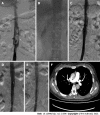Clinical outcomes of AngioJet pharmacomechanical thrombectomy versus catheter-directed thrombolysis for the treatment of filter-related caval thrombosis
- PMID: 36793643
- PMCID: PMC9923866
- DOI: 10.12998/wjcc.v11.i3.598
Clinical outcomes of AngioJet pharmacomechanical thrombectomy versus catheter-directed thrombolysis for the treatment of filter-related caval thrombosis
Abstract
Background: The inferior vena cava filter is utilized worldwide to intercept thrombi and to reduce the risk of fatal pulmonary embolism (PE). However, filter-related thrombosis is a complication of filter implantation. Endovascular methods such as AngioJet rheolytic thrombectomy (ART) and catheter-directed thrombolysis (CDT) can treat filter-related caval thrombosis, but the clinical outcomes of both treatment modalities have not been determined.
Aim: To compare the treatment outcomes of AngioJet rheolytic thrombectomy vs catheter-directed thrombolysis in patients with filter-related caval thrombosis.
Methods: In this single-center retrospective study, 65 patients (34 males and 31 females; mean age: 59.0 ± 13.43 years) with intrafilter and inferior vena cava thrombosis were enrolled between January 2021 and August 2022. These patients were assigned to either the AngioJet group (n = 44) or the CDT group (n = 21). Clinical data and imaging information were collected. Evaluation measures included thrombus clearance rate, periprocedural complications, urokinase dosage, incidence of PE, limb circumference difference, length of stay, and filter removal rate.
Results: Technical success rates were 100% in the AngioJet and CDT groups. In the AngioJet group, grade II and grade III thrombus clearance was achieved in 26 (59.09%) and 14 (31.82%) patients, respectively. In the CDT group, grade II and grade III thrombus clearance was accomplished in 11 (52.38%) patients and 8 (38.10%) patients, respectively (P > 0.05).The peridiameter difference of the thigh was significantly reduced in patients from both groups after treatment (P < 0.05). The median dosage of urokinase was 0.08 (0.02, 0.25) million U in the AngioJet group and 1.50 (1.17, 1.83) million U in the CDT group (P < 0.05). Minor bleeding was shown in 4 (19.05%) patients in the CDT group, and when it was compared with that in the AngioJet group, the difference was statistically significant (P < 0.05). No major bleeding occurred. Seven (15.91%) patients in the AngioJet group had hemoglobinuria and 1 (4.76%) patient in the CDT group had bacteremia. There were 8 (18.18%) patients with PE in the AngioJet group and 4 (19.05%) patients in the CDT group before the intervention (P > 0.05). Computed tomography angiopulmonography (CTA) showed that PE was resolved after the intervention. New PE occurred in 4 (9.09%) patients in the AngioJet group and in 2 (9.52%) patients in the CDT group after theintervention (P > 0.05). These cases of PE were asymptomatic. The mean length of stay was longer in the CDT group (11.67 ± 5.34 d) than in the AngioJet group (10.64 ± 3.52 d) (P < 0.05). The filter was successfully retrieved in the first phase in 10 (47.62%) patients in the CDT group and in 15 (34.09%) patients in the AngioJet group (P > 0.05).Cumulative removal was accomplished in 17 (80.95%) out of 21 patients in the CDT group and in 42 (95.45%) out of 44 patients in the ART group (P > 0.05). The median indwelling time for patients with successful retrieval was 16 (13139) d in the CDT group and 59 (12231) d in the ART group (P > 0.05).
Conclusion: Compared with catheter-directed thrombolysis, AngioJet rheolytic thrombectomy can achieve similar thrombus clearance effects, improve the filter retrieval rate, reduce the urokinase dosage and lower the risk of bleeding events in patients with filter-related caval thrombosis.
Keywords: AngioJet rheolytic thrombectomy; Catheter-directed thrombolysis; Clinical outcome; Inferior vena cava filter; Thrombosis.
©The Author(s) 2023. Published by Baishideng Publishing Group Inc. All rights reserved.
Conflict of interest statement
Conflict-of-interest statement: All the authors declare that they have no competing interests.
Figures



Similar articles
-
AngioJet rheolytic thrombectomy coupled with dose-reduced rt-PA for massive inferior vena cava filter-related thrombosis: A single-center retrospective study.Asian J Surg. 2024 Jan;47(1):263-268. doi: 10.1016/j.asjsur.2023.08.098. Epub 2023 Oct 3. Asian J Surg. 2024. PMID: 37798188
-
Comparing anticoagulant therapy alone, anticoagulant therapy in combination with catheter-directed thrombolysis, and anticoagulant therapy in combination with pharmacomechanical catheter-directed thrombolysis in the patients with optional inferior vena cava filter-related thrombosis: A single-center retrospective study.Vascular. 2024 Oct 12:17085381241289825. doi: 10.1177/17085381241289825. Online ahead of print. Vascular. 2024. PMID: 39395023
-
Outcome of AngioJet mechanical thrombus aspiration in the treatment of acute lower extremities deep venous thrombosis.Vascular. 2021 Jun;29(3):415-423. doi: 10.1177/1708538120958595. Epub 2020 Sep 22. Vascular. 2021. PMID: 32957848
-
Endovascular Treatment of Thrombosis and Embolism.Adv Exp Med Biol. 2017;906:195-213. doi: 10.1007/5584_2016_116. Adv Exp Med Biol. 2017. PMID: 27664152 Review.
-
Efficacy and Safety of Systemic Thrombolysis and Catheter-Directed Therapy in Pulmonary Embolism: A Narrative Review.Cureus. 2024 Nov 20;16(11):e74086. doi: 10.7759/cureus.74086. eCollection 2024 Nov. Cureus. 2024. PMID: 39712851 Free PMC article. Review.
Cited by
-
The Prevalence of Cardiovascular Complications and Causes of AngioJet Failure: A Post-Marketing Surveillance Study Based on the MAUDE (Manufacturer and User Facility Device Experience) Database.Cureus. 2023 Aug 1;15(8):e42824. doi: 10.7759/cureus.42824. eCollection 2023 Aug. Cureus. 2023. PMID: 37664247 Free PMC article.
References
-
- Patel K, Fasanya A, Yadam S, Joshi AA, Singh AC, DuMont T. Pathogenesis and Epidemiology of Venous Thromboembolic Disease. Crit Care Nurs Q. 2017;40:191–200. - PubMed
-
- Melman WP, Ettema HB, Verheyen CC. Symptomatic venous thromboembolism after trauma surgery: a study on 56.884 procedures. Acta Orthop Belg. 2020;86:363–368. - PubMed
-
- Barrera LM, Perel P, Ker K, Cirocchi R, Farinella E, Morales Uribe CH. Thromboprophylaxis for trauma patients. Cochrane Database Syst Rev. 2013:CD008303. - PubMed
-
- Kearon C, Akl EA, Comerota AJ, Prandoni P, Bounameaux H, Goldhaber SZ, Nelson ME, Wells PS, Gould MK, Dentali F, Crowther M, Kahn SR. Antithrombotic therapy for VTE disease: Antithrombotic Therapy and Prevention of Thrombosis, 9th ed: American College of Chest Physicians Evidence-Based Clinical Practice Guidelines. Chest. 2012;141:e419S–e496S. - PMC - PubMed
LinkOut - more resources
Full Text Sources

